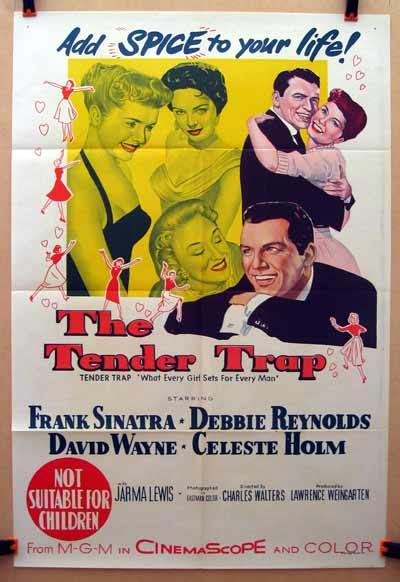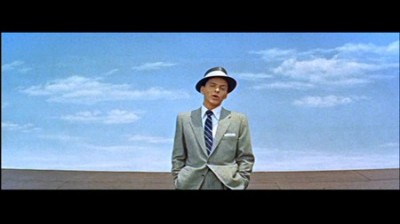THE TENDER TRAP, directed by Charles Walters and written by Julius Epstein, with Frank Sinatra, Debbie Reynolds, David Wayne, and Celeste Holm (1955, 111 min.)
Last night, I started out watching SINNER’S HOLIDAY (1930), with the first film appearance of James Cagney, and wound up seeing all of THE TENDER TRAP (1955) instead. Not because the latter is necessarily superior in any way -– only because I was 13 years old and saw THE TENDER TRAP when it came out, whereas I was years away from even being conceived when SINNER’S HOLIDAY made its first appearance, which means that the 1955 movie has more personal significance.
I suspected that a prefemninist comedy about swinging bachelorhood like THE TENDER TRAP would turn out to look archaic now in its sexism, and was pleasantly surprised to find that, apart from the standard 50s dogma that marriage and family were the solutions to every problem, these suspicions were mainly misguided. If anything, the film takes considerable pains to undermine at least a few of the myths of swinging bachelorhood -– even if the spacious living room in Sinatra’s Manhattan flat is almost oversized enough to justify the parody version of such a place in the 2003 DOWN WITH LOVE.
For a still better example of ridiculously large Manhattan penthouses, check out the flat shared by Lauren Bacall, Betty Grable, and Marilyn Monroe in the 1953 HOW TO MARRY A MILLIONAIRE –- none of whom even approaches being a millionaire when the three of them move in — and Sinatra’s “swinging” bachelor pad in COME BLOW YOUR HORN eight years after THE TENDER TRAP. (The latter is also complicated by a tortured effort to remove all the ethnic trimmings of Neil Simon’s Jewish play associated with Sinatra while mysteriously retaining those with all three members of his character’s family, namely, Tony Bill, Lee J. Cobb, and Molly Picon.)

What also surprises me about THE TENDER TRAP is that, as in SINNER’S HOLIDAY (where Cagney and Joan Blondell play the second leads), it’s the secondary characters who turn out to be the most interesting, nuanced, and sympathetic -– in this case, David Wayne and Celeste Holm, not Frank Sinatra and Debbie Reynolds.
Both Sinatra and Reynolds are directed by Walters so that the uptightness of both of their characters keeps getting on our nerves. Wayne plays Sinatra’s old buddy from the hinterlands who’s long been married and has three kids; he’s visiting his chum in the big city to take a vacation from his wife, and immediately becomes green with envy when faced with Sinatra’s steady stream of attractive girlfriends -– one of whom, the most serious, is Holm, a classical violinist who’s the only woman in a symphony orchestra. The movie obviously prefers these two relatively laid-back and wise characters to the leads -– even if the one-sheet poster that’s reproduced here omits Wayne -– and asks us to do the same.
Unless you’ve caught much of either Wayne or Holm on TV reruns (they both did a lot of TV), you may not be very familiar with either of them, at least if you weren’t alive and watching movies in the early 50s, but both were around a lot -– especially Wayne, who seemed to snag all the little-guy roles that later went to the far less charismatic Tom Ewell. Holm seemed to wind up with a lot of high-class or upper-crust parts, as in ALL ABOUT EVE and HIGH SOCIETY. But what makes her part special here isn’t her character’s class but her intelligence and integrity -– plus the fact that she’s unmarried, in her mid-30s, and doesn’t exactly deserve to be stigmatized for it (even though the movie makes damned sure that she does get married to somebody before the end title; an entire minor character gets invented for this purpose.)
In any case, the movie acknowledges the importance of the Wayne and Holm characters by having them both sing (or at least lip-sync) part of the title tune along with Sinatra and Reynolds at the very end, in the same abstract space provided to Sinatra during the film’s prologue. [6/13/08; upgraded and slightly expanded, 4/19/12]







